2019 Video In Business Benchmarks
- Home
- 2019 Video In Business Benchmarks
Breaking Down the Vidyard 2019 Benchmark Report for B2B Video Content
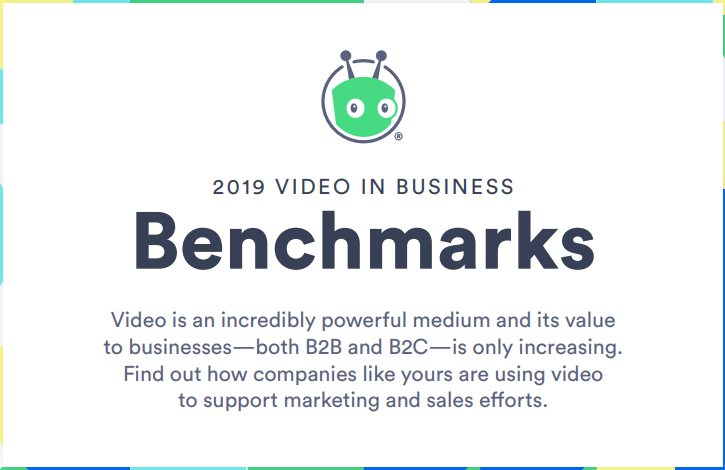
It's here! The Vidyard 2019 Benchmark Report has been an invaluable source of video content statistics over the last few years. This year's edition gives some incredible insights into the current B2B video marketing economy.
Here is a link to the full report.
So, what's in the report? What are the juicy details?
We read the entire report (a few times!) and pulled out the best parts. These are the trends that will shape video content marketing in 2019 - 2020.
If you're struggling with your video campaigns or you're on the fence about whether or not to invest more money in video marketing this year, this report should serve as evidence that video marketing is thriving. And, UK businesses should be looking to flesh out their content marketing budget to accommodate these latest trends.
Let's dive in!
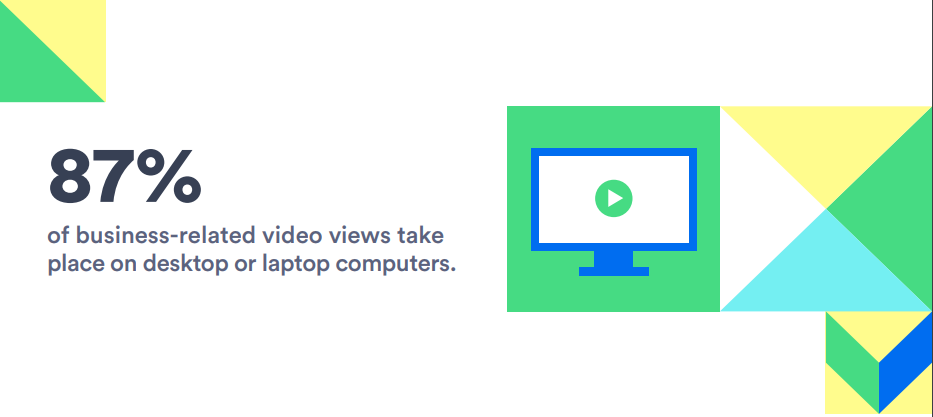 B2B Customers Still Love Desktop
B2B Customers Still Love Desktop
"87% of business-related video views take place on desktop or laptop computers."
To say that mobile is a dominant force in overall video viewership would be an understatement. Around 75% of total video viewership exists on mobile. And, that rises around 100% per year — making mobile the largest and fastest-growing video consumption outlet. But, that's total video viewership. What about B2B?
Desktop is still the king of B2B video marketing, grabbing 87% of ALL business video views. And, desktop is standing its ground against the rapidly encroaching mobile market. It's not all in desktop's favour, however. Mobile rates grew by 25% compared to last year, and its growth is expected to continue into the foreseeable future.
This trend has less to do with marketing and more to do with the current B2B tech stack. Desktop is still a critical component of the business workflows. But, as mobile apps and cloud connectivity creep into the once uncontested land of desktop apps, mobile will continue to grow at-pace with these changes.
How can you use this to your advantage?
B2B brands should still be focusing on desktop-first content. But, you should start increasing your mobile spend year-over-year in-line with mobile's growing popularity and use.
 Midweek is Prime Time for Videos
Midweek is Prime Time for Videos
"The most popular viewing times are Tuesday to Thursday between 9 and 11 a.m. PST (12 to 2 p.m. EST)."
Staying competitive with your video marketing campaigns requires A TON of content (more on this in the "Lots of Brands are Posting a Video-a-Day" section). And, if you're thinking about pumping out more than one video per week, scheduling that content can be a headache. Believe it or not, people are watching more videos — wait for it — on Tuesday, Wednesday, and Thursday.
17% of views happen on Tuesday, 18% occur on Wednesday, and a massive 22% happen on Thursday. Relatively speaking, the view differences between the weekdays aren't massive — Monday and Friday still sit at a cool 15%. But, Saturday and Sunday are definitely not the right time to be pushing out those B2B videos. Saturday only sees 6% of the views, and Sunday sits at 7%.
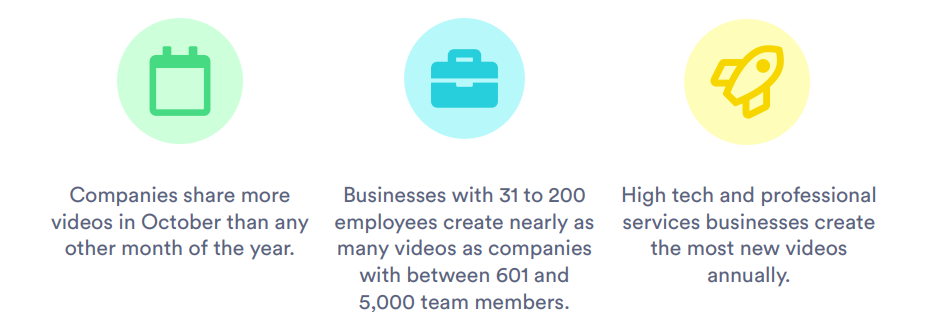 How can you use this to your advantage?
How can you use this to your advantage?
In other words, people like to watch your content while they're at work. And, you should mirror your content delivery strategy to match those times. So, if your target audience is filled with weekend warriors, don't pump out those videos during the weekdays just because of these statistics. Put out your content when your audience is working and ready to sneak in every little break possible.
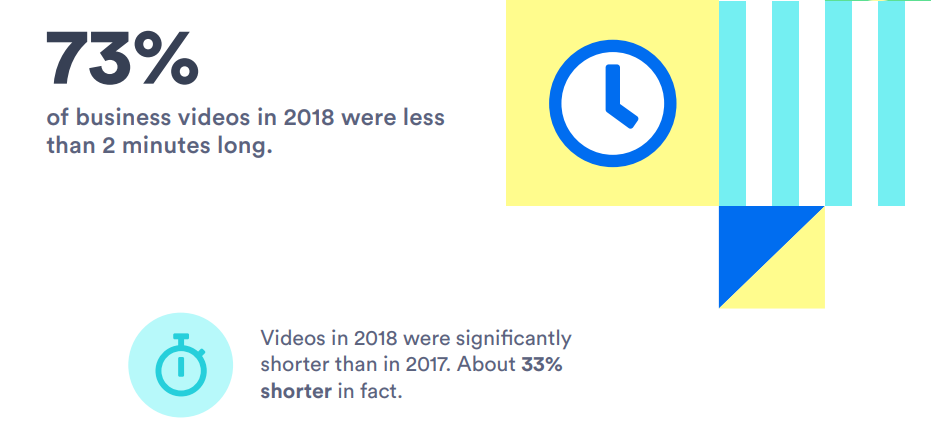 Keeping it Short
Keeping it Short
"73% of business videos in 2018 were less than 2 minutes long."
That's right! Almost 3 out of every 4 business video was under 2 minutes in length. And, that's not surprising. Back in 2017, Wyzowl's State of Video Marketing Report found that 95% of people expect content to be under 2 minutes. Plus, Microsoft conducted a study showing that the average attention span was around 8 seconds — and those are valuable seconds. This year videos were 33% shorter on average than last year according to the report. So, the wind is definitely blowing towards bite-size content that's posted often.
But, there's some hidden nuance here. Plenty of businesses are winning with long-form videos. In fact, 54% of video consumption happens on videos over 20 minutes long. So, there's wiggle room to go beyond the "snack size" videos. But, remember that the majority of people expect short videos. You should come with a blended portfolio of videos. And, you should save those 20-minute whoppers for bottom-funnel prospects.
How can you use this to your advantage?
Keep it short! Well, keep it short a lot. You can still pump out that killer long video pieces. In fact, your audience may be willing to binge on the whole thing.
 Viewers are Binging Videos
Viewers are Binging Videos
"52% of viewers will watch a video all the way to the end, on average."
B2B customers LOVE video content. Well, really, people LOVE videos. 55% of people view video content daily on their smartphones. So, it's not surprising that the users are eating up branded content. And, they're not just watching videos for a second and clicking on to the next. Half of them will consume the entire thing.
When you consider that 72% of customers prefer learning about your product through a video and that they're retaining 95% of the information contained in those videos (as opposed to 10% with text), video marketing pans out to be one of the single best avenues for B2B brands looking to make an impression. And, if you're just figuring this out — you're late to the party. 81% of brands are already using video as a core tenant of their overall marketing strategy.
Guess what! 25% of people are watching videos over 20 minutes all the way until the end as well. So, it's not just those snacky videos that make a splash.
How can you use this to your advantage?
Feel free to push some juicy info into the middle-to-end of your videos. Sure, you should try to brand in the first 5 seconds (especially when it comes to ads) But, keep the whole video packed with interesting, branded content. Remember, people are watching.
Lots of Brands are Posting a Video-a-Day
"On average, businesses in high tech, professional services, and media, entertainment, and communications post 300 videos a year."
Oh boy! You better get to work! That's right — tech, professional services, and media/entertainment companies are putting out a staggering amount of content on average. 300 videos a year is almost one-a-day, and, if you exist in these verticals, it's time to up your game. The overwhelming number of videos pushed out by these brands isn't surprising. In the UK (tech alone constituted around 20% of new hires in London last year), the US, and Canada tech and media are two of the five most competitive industries. And, professional service brands often fight tooth and nail for high-value leads.
How can you use this to your advantage?
Brands in almost every industry should be increasing their inbound spending over the next year. The UK and Britain together achieved a whopping $52 billion last year, and this is expected to increase in 2019. And, if you exist in one of those industries, part of that budget should go straight into video content. Don't just blend video into your marketing spend budget as a component of inbound; make it its own column.
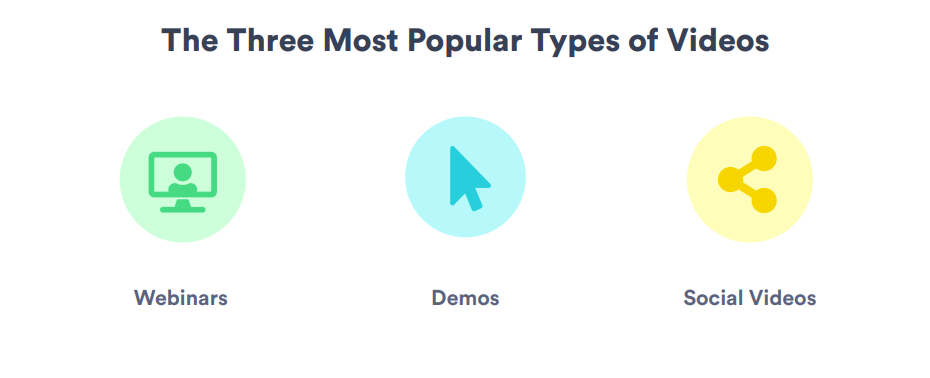 Looking at the Most Popular Video Types
Looking at the Most Popular Video Types
"The most common types of business video investments are webinars, demos, and social media videos."
According to an InsideSales report, 73% of marketers think that webinars are one of the best ways to generate leads. Plus, demos can increase purchase intent by 1.8x, and around 50% of people are looking for videos immediately about a product or service before they make a purchase. Not to mention, 4 out of 5 users believe that demos are helpful during their product search.
The increase in social media spends on par with its industry growth. As LinkedIn and other valuable B2B social platforms continue to gain traction year-over-year, social media has become a critical driver of success for almost every business on the planet. Case in point, over 50% of prospects will engage with your brand after watching your branded social media videos.
How can you use this to your advantage?
The interesting thing here isn't that demos, webinars, and social media videos are valuable — it's that they're all valuable. And, the rest of the list (explainer videos, product videos, customer videos, how-to videos, thought leadership, and live streams) were utilised at well over 30%. Make sure you have a blended content strategy that includes a plethora of video types to target users at every stage of your funnel and at every twist and turn in your pipeline.
Where Brands Are Embedding Videos
"Websites, social media, and landing pages are three of the most popular places to embed video content."
For many brands figuring out which kinds of videos to create is difficult. But, finding out where to put those videos can be downright stressful. How do you leverage your videos to both engage and convert? Can you use videos as a magnet for leads? Where can you plop those rich media creatives to make the biggest impact on prospects?
Well, marketers seem to think that websites, social media, and landing pages are the go-to. And, there's plenty of research to back them up. Simply plopping a video on your landing pages can boost conversion rates by 86%. And, having a video on your landing page increases its chances of ranking 1st on SERP by over 50%. There's certainly value in video-driven landing pages.
But, how about social media?
- Posts with videos get almost 50% more views on average.
- Videos generate 1,200% more shares than text or image-based posts.
- Video campaigns on LinkedIn have 50% view rates!
And, as the cherry on top, simply having videos on your website boosts its chance to rank 1st on Google by a whopping 5,300%. That's 53x better ranking potential
How can you use this to your advantage?
Are you having trouble ranking, generating engagement, getting views, or converting prospects? Start embedding videos on those campaigns!
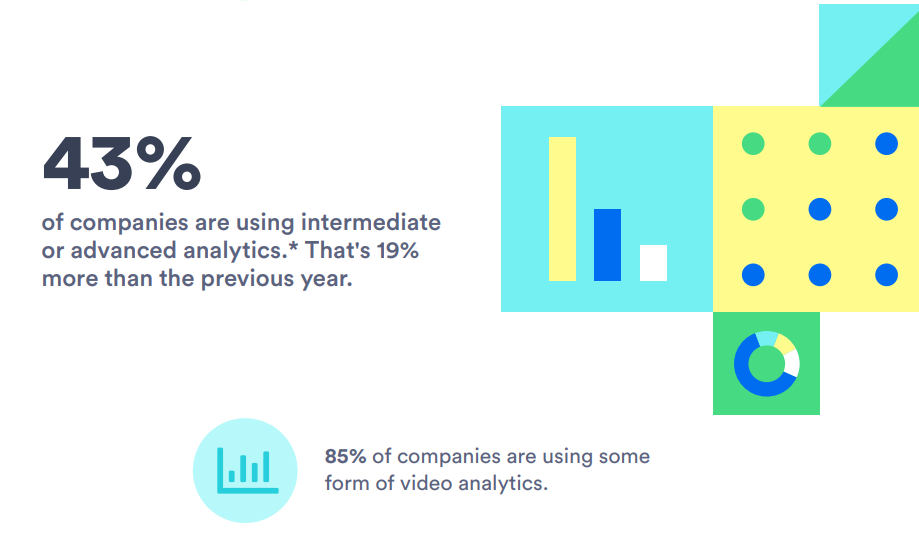 It's All About the Analytics
It's All About the Analytics
"In 2018, 85% of companies reported using some form of video analytics."
The money is in the data. Lots of marketers struggle with measuring performance. It's not enough to throw up a few videos; you need to know what works and what doesn't. And, to that end, you need to figure out what you can tweak to get a higher ROI. Video creatives aren't the cheapest asset in the marketing toolbox. So, constantly measuring and analysing results is key for brands looking to produce the highest engagement rates, views, and conversions possible.
According to HubSpot, the second biggest challenge (behind generating leads of course) for marketers is proving the ROI of campaigns. Brands want to see results. No amount of statistics, research, or case studies can beat a solid ROI — it's the be-all-end-all. Analytics is how you measure that ROI and leverage results to build better content.
How can you use this to your advantage?
Always be measuring. Dive deep into analytics, and constantly tweak your campaigns to boost ROI.
 Brands Continue to Lean on External Content Producers
Brands Continue to Lean on External Content Producers
"This year, more small and medium companies moved towards using a mix of internal and external resources for video production than the previous year. Now 52% are using both."
Finally, the last, and probably most valuable, piece of information in the study is this — you should leverage both internal and external teams. For years, marketers have been leaning on either in-house teams (if they can afford them) or agencies. But, as branding evolves into the key differentiator between brands (over price and product), finding ways to create the best possible branded content is the lever that unlocks brand value.
An agency gives you an outside view of your organisation. They help you create incredibly rich campaigns focused on branding, ROI, and engagement. But, your internal team can stay consistent with some of your more nuanced internal goals. The combined views of BOTH teams are invaluable for businesses looking to stay hyper-competitive in the digital-first marketing economy.
How can you use this to your advantage?
If you're a small business, build a small, but capable, in-house marketing team. And, lean on your preferred agency to help you create ROI-driven videos and campaigns.
Final Thoughts
B2B video marketing is thriving. And, it's a hyper-competitive market filled with nuance and plenty of engagement.
Resources
- Take a look at the comprehensive list of content on the Whitehat video library
